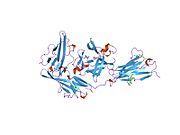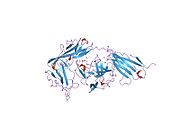Interleukin 1 receptor, type I (IL1R1) also known as CD121a (Cluster of Differentiation 121a), is an interleukin receptor. IL1R1 also denotes its human gene.[5]
The protein encoded by this gene is a cytokine receptor that belongs to the interleukin-1 receptor family. This protein is a receptor for interleukin 1 alpha (IL1A), interleukin 1 beta (IL1B), and interleukin 1 receptor antagonist (IL1RA). It is an important mediator involved in many cytokine induced immune and inflammatory responses. This gene along with interleukin 1 receptor, type II (IL1R2), interleukin 1 receptor-like 2 (IL1RL2), and interleukin 1 receptor-like 1 (IL1RL1) form a cytokine receptor gene cluster in a region mapped to chromosome 2q12.[5]
Interactions
[edit]Interleukin 1 receptor, type I has been shown to interact with PIK3R1,[6] Myd88[7][8] and IL1RAP.[9]
See also
[edit]References
[edit]- ^ a b c GRCh38: Ensembl release 89: ENSG00000115594 – Ensembl, May 2017
- ^ a b c GRCm38: Ensembl release 89: ENSMUSG00000026072 – Ensembl, May 2017
- ^ "Human PubMed Reference:". National Center for Biotechnology Information, U.S. National Library of Medicine.
- ^ "Mouse PubMed Reference:". National Center for Biotechnology Information, U.S. National Library of Medicine.
- ^ a b "Entrez Gene: IL1R1 interleukin 1 receptor, type I".
- ^ Reddy, S A; Huang J H; Liao W S (November 1997). "Phosphatidylinositol 3-kinase in interleukin 1 signaling. Physical interaction with the interleukin 1 receptor and requirement in NFkappaB and AP-1 activation". J. Biol. Chem. 272 (46). UNITED STATES: 29167–73. doi:10.1074/jbc.272.46.29167. ISSN 0021-9258. PMID 9360994.
- ^ Burns, K; Clatworthy J; Martin L; Martinon F; Plumpton C; Maschera B; Lewis A; Ray K; Tschopp J; Volpe F (June 2000). "Tollip, a new component of the IL-1RI pathway, links IRAK to the IL-1 receptor". Nat. Cell Biol. 2 (6). ENGLAND: 346–51. doi:10.1038/35014038. ISSN 1465-7392. PMID 10854325. S2CID 32036101.
- ^ Muzio, M; Ni J; Feng P; Dixit V M (November 1997). "IRAK (Pelle) family member IRAK-2 and MyD88 as proximal mediators of IL-1 signaling". Science. 278 (5343). UNITED STATES: 1612–5. Bibcode:1997Sci...278.1612M. doi:10.1126/science.278.5343.1612. ISSN 0036-8075. PMID 9374458.
- ^ Huang, J; Gao X; Li S; Cao Z (November 1997). "Recruitment of IRAK to the interleukin 1 receptor complex requires interleukin 1 receptor accessory protein". Proc. Natl. Acad. Sci. U.S.A. 94 (24). UNITED STATES: 12829–32. Bibcode:1997PNAS...9412829H. doi:10.1073/pnas.94.24.12829. ISSN 0027-8424. PMC 24223. PMID 9371760.
Further reading
[edit]- Copeland NG, Silan CM, Kingsley DM, et al. (1991). "Chromosomal location of murine and human IL-1 receptor genes". Genomics. 9 (1): 44–50. doi:10.1016/0888-7543(91)90219-5. PMID 1672292.
- McMahan CJ, Slack JL, Mosley B, et al. (1991). "A novel IL-1 receptor, cloned from B cells by mammalian expression, is expressed in many cell types". EMBO J. 10 (10): 2821–32. doi:10.1002/j.1460-2075.1991.tb07831.x. PMC 452992. PMID 1833184.
- Uhl J, Newton RC, Giri JG, et al. (1989). "Identification of IL-1 receptors on human monocytes". J. Immunol. 142 (5): 1576–81. doi:10.4049/jimmunol.142.5.1576. PMID 2521881. S2CID 28462235.
- Sims JE, Acres RB, Grubin CE, et al. (1989). "Cloning the interleukin 1 receptor from human T cells". Proc. Natl. Acad. Sci. U.S.A. 86 (22): 8946–50. Bibcode:1989PNAS...86.8946S. doi:10.1073/pnas.86.22.8946. PMC 298407. PMID 2530587.
- Chua AO, Gubler U (1990). "Sequence of the cDNA for the human fibroblast type interleukin-1 receptor". Nucleic Acids Res. 17 (23): 10114. doi:10.1093/nar/17.23.10114. PMC 335251. PMID 2532321.
- Dower SK, Kronheim SR, Hopp TP, et al. (1987). "The cell surface receptors for interleukin-1 alpha and interleukin-1 beta are identical". Nature. 324 (6094): 266–8. Bibcode:1986Natur.324..266D. doi:10.1038/324266a0. PMID 2946959. S2CID 4233242.
- Rautonen N, Rautonen J, Martin NL, Wara DW (1995). "HIV-1 Tat induces cytokine synthesis by uninfected mononuclear cells". AIDS. 8 (10): 1504–6. doi:10.1097/00002030-199410000-00023. PMID 7818827.
- Vigers GP, Anderson LJ, Caffes P, Brandhuber BJ (1997). "Crystal structure of the type-I interleukin-1 receptor complexed with interleukin-1beta". Nature. 386 (6621): 190–4. Bibcode:1997Natur.386..190V. doi:10.1038/386190a0. PMID 9062193. S2CID 4358379.
- Schreuder H, Tardif C, Trump-Kallmeyer S, et al. (1997). "A new cytokine-receptor binding mode revealed by the crystal structure of the IL-1 receptor with an antagonist". Nature. 386 (6621): 194–200. Bibcode:1997Natur.386..194S. doi:10.1038/386194a0. PMID 9062194. S2CID 4266953.
- Rameshwar P, Poddar A, Zhu G, Gascón P (1997). "Receptor induction regulates the synergistic effects of substance P with IL-1 and platelet-derived growth factor on the proliferation of bone marrow fibroblasts". J. Immunol. 158 (7): 3417–24. doi:10.4049/jimmunol.158.7.3417. PMID 9120302. S2CID 24164798.
- Reddy SA, Huang JH, Liao WS (1997). "Phosphatidylinositol 3-kinase in interleukin 1 signaling. Physical interaction with the interleukin 1 receptor and requirement in NFkappaB and AP-1 activation". J. Biol. Chem. 272 (46): 29167–73. doi:10.1074/jbc.272.46.29167. PMID 9360994.
- Huang J, Gao X, Li S, Cao Z (1998). "Recruitment of IRAK to the interleukin 1 receptor complex requires interleukin 1 receptor accessory protein". Proc. Natl. Acad. Sci. U.S.A. 94 (24): 12829–32. Bibcode:1997PNAS...9412829H. doi:10.1073/pnas.94.24.12829. PMC 24223. PMID 9371760.
- Muzio M, Ni J, Feng P, Dixit VM (1997). "IRAK (Pelle) family member IRAK-2 and MyD88 as proximal mediators of IL-1 signaling". Science. 278 (5343): 1612–5. Bibcode:1997Sci...278.1612M. doi:10.1126/science.278.5343.1612. PMID 9374458.
- Dale M, Nicklin MJ (1999). "Interleukin-1 receptor cluster: gene organization of IL1R2, IL1R1, IL1RL2 (IL-1Rrp2), IL1RL1 (T1/ST2), and IL18R1 (IL-1Rrp) on human chromosome 2q". Genomics. 57 (1): 177–9. doi:10.1006/geno.1999.5767. PMID 10191101.
- Sizemore N, Leung S, Stark GR (1999). "Activation of phosphatidylinositol 3-kinase in response to interleukin-1 leads to phosphorylation and activation of the NF-kappaB p65/RelA subunit". Mol. Cell. Biol. 19 (7): 4798–805. doi:10.1128/mcb.19.7.4798. PMC 84278. PMID 10373529.
- Burns K, Clatworthy J, Martin L, et al. (2000). "Tollip, a new component of the IL-1RI pathway, links IRAK to the IL-1 receptor". Nat. Cell Biol. 2 (6): 346–51. doi:10.1038/35014038. PMID 10854325. S2CID 32036101.
- Vigers GP, Dripps DJ, Edwards CK, Brandhuber BJ (2001). "X-ray crystal structure of a small antagonist peptide bound to interleukin-1 receptor type 1". J. Biol. Chem. 275 (47): 36927–33. doi:10.1074/jbc.M006071200. PMID 10903327.
- Lin H, Ho AS, Haley-Vicente D, et al. (2001). "Cloning and characterization of IL-1HY2, a novel interleukin-1 family member". J. Biol. Chem. 276 (23): 20597–602. doi:10.1074/jbc.M010095200. PMID 11278614.
- Joos L, McIntyre L, Ruan J, et al. (2001). "Association of IL-1beta and IL-1 receptor antagonist haplotypes with rate of decline in lung function in smokers". Thorax. 56 (11): 863–6. doi:10.1136/thorax.56.11.863. PMC 1745962. PMID 11641511.
- Köller M, Kutscha-Lissberg F, Brom J, et al. (2003). "Influence of low molecular weight heparin (certoparin) and unfractionated heparin on the release of cytokines from human leukocytes". Inflammation. 25 (5): 331–7. doi:10.1023/A:1012883916991. PMID 11820460. S2CID 21831719.
External links
[edit]- IL1R1+protein,+human at the U.S. National Library of Medicine Medical Subject Headings (MeSH)
This article incorporates text from the United States National Library of Medicine, which is in the public domain.









Well, that’s interesting to know that Psilotum nudum are known as whisk ferns. Psilotum nudum is the commoner species of the two. While the P. flaccidum is a rare species and is found in the tropical islands. Both the species are usually epiphytic in habit and grow upon tree ferns. These species may also be terrestrial and grow in humus or in the crevices of the rocks.
View the detailed Guide of Psilotum nudum: Detailed Study Of Psilotum Nudum (Whisk Fern), Classification, Anatomy, Reproduction